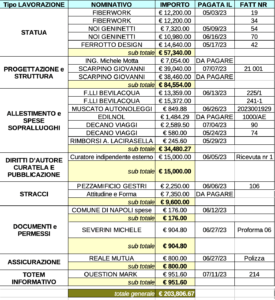Last week, the Venus of the Rags in Naples was trending globally: the world’s media echoed the burning of Michelangelo Pistoletto‘s work on 12 July. As reported in a previous article, the “Neapolitan” version, a copy of the original one on monumental scale, had been made by Cittadellarte and designed specifically for Naples. The police seem to have identified the person responsible for the fire thanks to the video surveillance system. Cittadellarte’s director Paolo Naldini is keen to disclose the costs of the installation in reference to both the construction costs and the estimated re-construction costs, with the publication of two tables summarising the details of all the expenses.
Paolo, let’s shed some light on the expenses relating to the Venus of the Rags in Naples. What are the costs of the operation in detail?
The cost of the project consists entirely of out-of-pocket expenses, without any remuneration for either Pistoletto or the Foundation, who donated the installation and the design and construction work to the City of Naples.
The bulk of the cost was for the creation of the statue and the structure, over 140,000 euros. The setting up, also by outside firms, cost over 30,000 euros. The rest of the monies were for the rags and the necessary inspections and permits.
Let’s now look to the future. How will the rebirth of the work be supported financially?
The reconstruction proposed by the City of Naples will hopefully cost much less because we expect to receive compensation from the insurance company of perhaps 40,000 euros, but unfortunately this is by no means certain yet. In addition, there is a good chance that we can reuse the metal structure by repairing the places where it has been damaged, but even in this regard we must wait for the response of the experts, who will only be able to examine the structure once they are allowed by the authorities. Worst-case scenario (without compensation and without being able to reuse the metal structure in any way) the cost would be over 170,000 euros.
In conclusion, what is the situation regarding the reconstruction budget?
Like for the first installation, the reconstruction budget is entirely reserved for out-of-pocket expenses and nothing will be paid to Michelangelo Pistoletto or the Foundation. Even though the Foundation’s funds are limited and insufficient, and only part of them (72,000 euros in 2023) comes to us from the State through the Piedmont Region, this operation for Naples was decided by Michelangelo and the board of directors as an important gesture for global fashion, especially in months in which the international debate on the sustainability of the textile industry is taking important steps forward, also thanks to those who, like us, have been working for decades to raise awareness among the players in the supply chain and the consumers, as those who have followed our work with the United Nations and the National Chamber of Fashion know. We have actually instituted an Academy of Sustainable Fashion, the first in Italy to have three-year courses specifically dedicated to sustainability, directed by one of the most authoritative professionals in the sector (CSR manager for Armani, after years in a similar role at Gucci), because our cultural roots draw on the Venus of the Rags and the awareness that 56 years ago someone like Michelangelo, but also for example the Club of Rome, founded in ’68, had already developed. Although we lack public support, over the years we have met many entrepreneurs and institutions that have believed in our vision even when it was not yet “fashionable”.
Those who visit Cittadellarte in Biella today can see as many as three exhibitions and about ten video projects specifically dedicated to sustainable fashion and textile and circular culture. The great Venus of Naples has grown in proportion to the size of the 1967 work not only in relation to an artist’s ego, or because the size of Piazza del Municipio in Naples required important reflections on the spatiality of the work, but above all because the production and textile waste that today suffocates the Earth in places like the Atacama desert or the coasts of Ghana has grown enormously, as recently reported in the beautiful work of one of the fashion designers of our platform and school, Matteo Ward, who, together with WILL, has made a four-episode documentary on this very issue broadcasted by SKY. The amount of rags has grown, and so has the Venus representing humanity on Earth. Setting fire to all this has never seemed a reasonable and generative solution, except to the lovers of the spectacular and the symbolic, of whom there are unfortunately many: today we are actually in the process of defining an articulate European legislation (which will inevitably become part of national law, including the Italian one) that introduces a ban on burning unsold garments and textiles. This is a big step forward in regard to those who think it is better to burn works like waste, instead of regenerating and be regenerated by them.
See below the tables of actual and planned expenditure.



